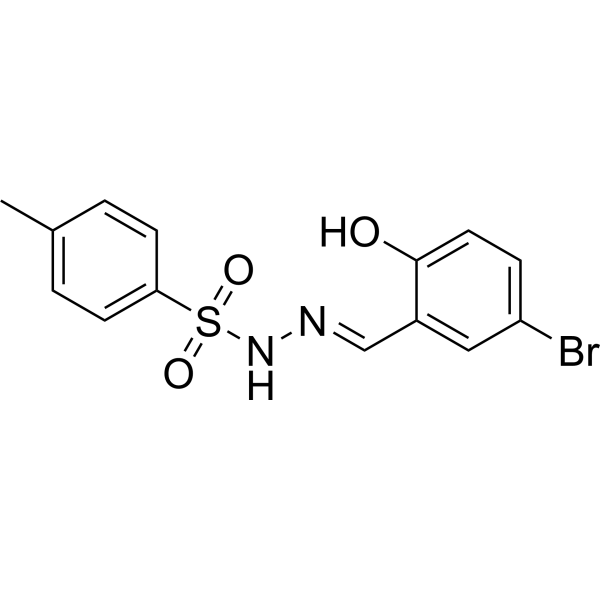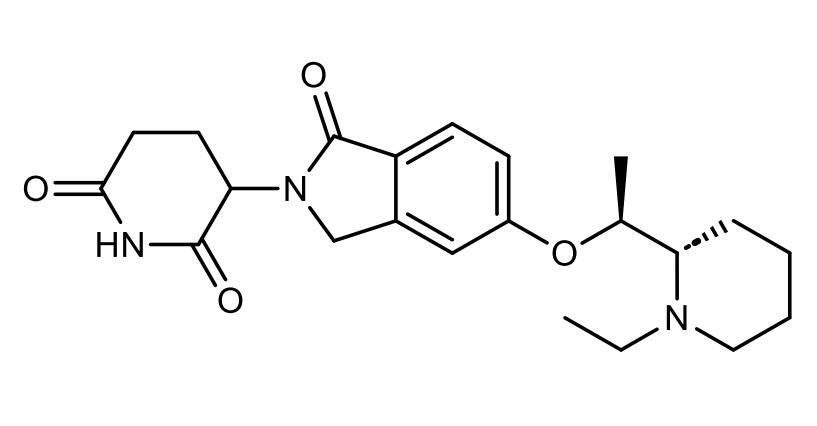 To enhance service speed and avoid tariff delays, we've opened a US warehouse. All US orders ship directly from our US facility.
To enhance service speed and avoid tariff delays, we've opened a US warehouse. All US orders ship directly from our US facility.
| Cat. No. | Product Name | Field of Application | Chemical Structure |
|---|---|---|---|
| DC67333 | MYC degrader 1 TFA Featured |
MYC degrader 1 TFA (compound A80.2HCl) is an orally available molecular glue degrader targeting MYC, exhibiting significant anti-tumor activity. It restores pRB1 protein function and re-establishes the sensitivity of MYC-overexpressing cancer cells to CDK4/6 inhibitors.
More description
|

|
| DC67357 | KT-333 diammonium Featured |
KT-333 diammonium is a molecular glue degrader that selectively targets STAT3 for proteasomal degradation by bridging interactions between STAT3 and the VHL E3 ubiquitin ligase complex. Exhibiting high specificity for STAT3 degradation, this compound demonstrates potent antitumor efficacy. Its therapeutic potential is particularly relevant in hematologic malignancies, including large granular lymphocytic leukemia (LGL-L), peripheral T-cell lymphoma (PTCL), and cutaneous T-cell lymphoma (CTCL).
More description
|

|
| DC67355 | Pomalidomide-d4 Featured |
Pomalidomide-d4 is a deuterium-labeled analog of pomalidomide, a third-generation immunomodulatory drug functioning as a molecular glue degrader. This compound selectively binds the cereblon E3 ubiquitin ligase complex, triggering targeted proteasomal degradation of Ikaros family transcription factors—a key mechanism underlying its therapeutic activity.
More description
|

|
| DC67366 | KT-333 ammonium Featured |
KT-333 ammonium (Compound A) is a targeted molecular glue degrader that induces STAT3 protein degradation via the ubiquitin-proteasome pathway. The compound facilitates this process by simultaneously engaging both STAT3 and the VHL E3 ubiquitin ligase, demonstrating remarkable degradation selectivity. With potent antitumor efficacy, KT-333 ammonium shows particular promise for investigating therapeutic interventions in hematologic malignancies, including large granular lymphocytic leukemia (LGL-L), peripheral T-cell lymphoma (PTCL), and cutaneous T-cell lymphoma (CTCL).
More description
|

|
| DC67393 | Pomalidomide-d5 Featured |
Pomalidomide-d5 is a deuterium-stabilized isotopologue of pomalidomide, a third-generation immunomodulatory drug that functions as a molecular glue degrader. This compound mediates targeted protein degradation by recruiting the cereblon E3 ubiquitin ligase to promote ubiquitination and proteasomal elimination of Ikaros family transcription factors (IKZF1/3), a mechanism central to its therapeutic activity.
More description
|

|
| DC67330 | MYC degrader 1 Featured |
MYC degrader 1 (compound A80.2HCl) is an orally available molecular glue degrader targeting MYC, with significant anti-tumor activity. It restores pRB1 protein function and re-establishes the sensitivity of MYC-overexpressing cancer cells to CDK4/6 inhibitors.
More description
|

|
| DC67337 | VNPP433-3β Featured |
VNPP433-3β is a first-in-class molecular glue degrader that simultaneously targets androgen receptor (AR), its splice variants (AR-Vs), and Mnk1/2 kinases for proteasomal degradation. This multimodal agent demonstrates potent anti-proliferative activity in castration-resistant prostate cancer (CRPC) models, with GI50 values of 0.2–0.31 μM in LNCaP, C4-2B, and CWR22Rv1 cells. Its robust in vivo efficacy, evidenced by tumor growth inhibition in CWR22Rv1 xenografts, is supported by favorable pharmacokinetics in CD-1 mice.
More description
|

|
| DC67361 | IKZF-IN-1 Featured |
IKZF-IN-1 (Compound I) is a molecular glue degrader that selectively targets IKZF1/2/3/4 (Ikaros zinc finger family proteins) for proteasomal degradation. This immunomodulatory compound holds therapeutic potential for investigating cancer and viral infection treatment strategies.
More description
|

|
| DC60858 | LC-04-045 Featured |
LC-04-045 is a leading NEK7 molecular glue degrader with DC50 of 7 nM and Dmax of 90 % in MOLT-4 cells. LC-04-045 displays high selectivity for NEK7 across the proteome.
More description
|

|
| DC67362 | QXG-6442 Featured |
QXG-6442 is a potent molecular glue degrader targeting CK1α, demonstrating high degradation efficiency (DC50 = 5.7 nM, Dmax = 90%). This compound significantly suppresses proliferation in the MOLM-14 leukemia cell line, highlighting its therapeutic potential.
More description
|

|
| DC60451 | MRT-2539 Featured |
MRT-2359 a potent, selective and orally bioavailable GSPT1-directed molecular glue degrader (MGD).
More description
|

|
| DC73179 | SW394703 |
SW394703 is a novel DDB1-dependent molecular glue degrader for cyclin K, SW394703 is toxic to HCT116 cells (IC50=1.2 uM).
More description
|

|
| DC67377 | JP-2-249 Featured |
JP-2-249 functions as a molecular glue degrader that selectively targets SMARCA2 for proteasomal degradation. In MV-4-11 leukemia cells, treatment with JP-2-249 (1–10 μM) induces dose-dependent reduction of SMARCA2 protein levels, demonstrating potent degradation activity.
More description
|

|
| DC66609 | PLX-4545 Featured |
PLX-4545 is an orally bioavailable molecular glue degrader that hijacks the cereblon E3 ubiquitin ligase complex to selectively target IKZF2 (Helios), a zinc finger transcription factor critical for regulatory T cell (Treg) function. By inducing proteasomal degradation of IKZF2, PLX-4545 disrupts Treg stability and reprograms these immunosuppressive cells into pro-inflammatory effector-like T cells, effectively shifting the tumor microenvironment toward immune activation.
More description
|

|
| DC74482 | CC-3240 Featured |
CC-3240 is an optimized molecular glue degrader derived from CC-8977, demonstrating high-affinity binding to CaMKK2 (IC50 = 9 nM) and potent degradation efficacy (DC50 = 100 nM in THP1 cells, Dmax = 92%). This novel compound effectively hijacks the ubiquitin-proteasome system to induce targeted CaMKK2 depletion, offering a superior pharmacological approach over traditional kinase inhibition.
More description
|

|
| DC67364 | dCK1α-2 Featured |
dCK1α-2 is an orally bioavailable molecular glue degrader targeting CK1α, a key regulator of p53 pathway signaling. This compound demonstrates robust in vivo anti-tumor activity in murine models while upregulating expression of p53-associated genes, highlighting its dual mechanism of action.
More description
|

|
| DC70109 | (R)-CR8 Featured |
(R)-CR8 (CR8), a second-generation derivative of Roscovitine, is a highly effective inhibitor of CDK1/2/5/7/9. It exhibits inhibitory activity against CDK1/cyclin B (IC50=0.09 μM), CDK2/cyclin A (0.072 μM), CDK2/cyclin E (0.041 μM), CDK5/p25 (0.11 μM), CDK7/cyclin H (1.1 μM), CDK9/cyclin T (0.18 μM), and CK1δ/ε (0.4 μM). (R)-CR8 induces apoptosis and demonstrates neuroprotective properties. Additionally, it functions as a molecular glue degrader, specifically targeting and depleting cyclin K.
More description
|

|
| DC67331 | MMH2 Featured |
MMH2 is a novel BRD4 molecular glue degrader that operates by recruiting the CUL4 and DCAF16 ligases to the second bromodomain of BRD4 (BRD4BD2).
More description
|

|
| DC67335 | MMH1 Featured |
MMH1 is a first-in-class molecular glue degrader that specifically targets the second bromodomain of BRD4 (BRD4BD2) through an innovative mechanism of action. By simultaneously engaging both BRD4BD2 and the CUL4-DCAF16 E3 ubiquitin ligase complex, MMH1 induces targeted protein degradation with exceptional specificity.
More description
|

|
| DC67329 | TMX1 Featured |
TMX1 is a covalent molecular glue degrader targeting BRD4. It selectively recruits DCAF16 to the BRD4BD2 domain, resulting in the degradation of BRD4.
More description
|

|
| DC60254 | HQ461 Featured |
HQ461 is a molecular glue degrader that facilitates the interaction between CDK12 and the DDB1-CUL4-RBX1 E3 ubiquitin ligase, resulting in the polyubiquitination and subsequent degradation of the CDK12-interacting protein Cyclin K (CCNK). This degradation impairs CDK12 function, leading to reduced phosphorylation of its substrates, downregulation of DNA damage response genes, and ultimately, cell death.
More description
|

|
| DC60777 | EN450 Featured |
EN450 is a cysteine-reactive covalent molecular glue degrader specifically designed to target NF-κB.
More description
|
.jpg)
|
| DC72726 | HQ005 Featured |
HQ005 is a highly efficient molecular glue degrader that induces the selective degradation of Cyclin K (CCNK) with exceptional potency (DC50 = 41 nM). By facilitating novel protein-protein interactions between CCNK and the ubiquitin-proteasome system, HQ005 promotes targeted ubiquitination and proteasomal clearance of CCNK, offering a precise pharmacological tool for modulating CDK12/13-dependent transcription and DNA damage response pathways.
More description
|

|
| DC50183 | dCeMM2 Featured |
dCeMM2 (Compound 2) is a molecular glue degrader that drives the ubiquitination and degradation of cyclin K. It achieves this by facilitating an interaction between the CDK12-cyclin K complex and the CRL4B ligase complex.
More description
|

|
| DC70900 | WBC100 Featured |
WBC100 (14-D-Valine-TPL) is a potent, selective, and orally active molecular glue degrader targeting c-Myc. It facilitates the degradation of c-Myc through the ubiquitin E3 ligase CHIP-mediated 26S proteasome pathway. WBC100 is specifically utilized for research involving c-Myc overexpressing tumors.
More description
|

|
| DC60567 | dCeMM1 Featured |
dCeMM1 is a molecular glue degrader targeting RBM39. It functions by redirecting the activity of the CRL4DCAF15 ligase, leading to a reduction in RBM39 levels in WT KBM7 cells.
More description
|

|
| DC60837 | MGD-28 Featured |
MGD-28 is a potent molecular glue degrader that demonstrates significant in vitro efficacy against various hematological cancer cell lines. It induces degradation of Ikaros family zinc finger proteins 1, 2, and 3 (IKZF1/2/3) and casein kinase 1 alpha (CK1α) with nanomolar potency via a Cullin-cereblon (CRBN) dependent pathway. Compared to lenalidomide and pomalidomide, MGD-28 achieves deeper, faster, and more potent degradation of these neosubstrates. Additionally, MGD-28 exhibits broad antiproliferative activity in multiple solid malignancies and shows preferential cytotoxicity toward multiple myeloma patient-derived cells at various disease stages.
More description
|

|
| DC60617 | dWIZ-1 Featured |
dWIZ-1 is a first-in-class molecular glue degrader that specifically targets the WIZ transcription factor for proteasomal degradation, leading to potent induction of fetal hemoglobin (HbF) in erythroblasts. This novel compound functions by enhancing the interaction between CRBN and WIZ, demonstrating an EC50 of 547 nM for CRBN-WIZ complex formation.
More description
|

|
| DC50184 | dCeMM3 Featured |
dCeMM3 (Compound 3) is a molecular glue degrader that facilitates the ubiquitination and degradation of cyclin K. It achieves this by promoting an interaction between the CDK12-cyclin K complex and the CRL4B ligase complex.
More description
|

|
| DCC3332 | Mg-277 Featured |
MG-277, a molecular glue degrader, efficiently induces the degradation of the translation termination factor GSPT1, based on the Cereblon E3 ligand, with a DC50 of 1.3 nM. It potently inhibits tumor cell growth in a p53-independent manner, demonstrating IC50 values of 3.5 nM for RS4;11 cells and 3.4 nM for p53 mutant RS4;11/IRMI-2 cells. MG-277 exhibits significant anticancer activity.
More description
|

|